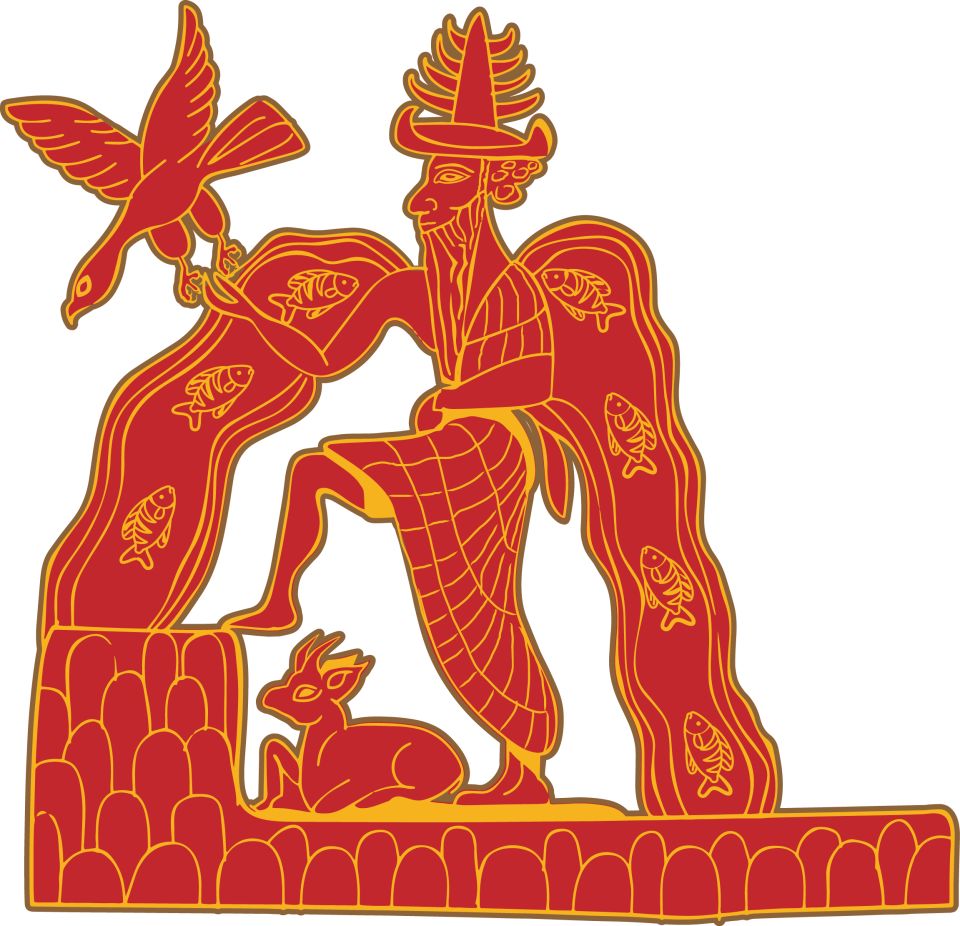 |
| Enlil, Şamaş, İştar, Adad |
MEZOPOTAMYA VE İRAN MİTOLOJİLERİNDE TANRI ANLAYIŞI
ÖZET
Sümer kültüründe, kent merkezli bir tanrı anlayışı oluşmuştur. Kent tanrısının, ailesi ve hizmetkârlarıyla tapınakta yaşadığına inanılmıştır. Kent tanrılarının heykelleri yapılmıştır. Uruk, Eridu ve Nippur kentleri ön plana çıkarak, Sümer panteonun gelişmesine katkı sağlamışlardır.
Akad Devleti ile beraber Sami halkları, Sümer tanrı anlayışından etkilenerek, kendi sentezlerini oluşturmuşlardır. Sümer tanrılarına, Sami isimleri verilerek Sami inançlarında yer verilmiştir. Orta Babil Dönemi’nde Marduk, tanrıların efendisi konumuna yükseltilmiştir. Asur’da, tanrı Asur en önemli tanrıdır ve Asur’da diğer Mezopotamya tanrılarına da inanıldığı görülmektedir. Zamanla tanrı Asur, tanrıların kralı olarak görülmüştür. Yeni Asur Dönemi’nde ise tanrı Marduk ile özdeşleştirilmek istenmiştir. Babil Yaratılış Destanı’nın, Asur versiyonu oluşturulmuş, tanrı Marduk’un yerine tanrı Asur geçirilmiştir.
Eski İran’da, Ahameniş ve Gatha’lar olarak iki farklı gelenekte tek tanrı olarak Ahura Mazda’ya inanıldığı görülür. II. Artakserkses dönemi ile beraber Anahita ve Mitra’ya da Ahameniş kitabelerinde yer verilmiştir. Gatha’lar sonrası Avesta metinleri, tek tanrı yapısını kaybederek, çok tanrılı bir yapıya dönüşmüştür. İlk dönemlerde tanrı heykeli ve tapınak yapımı yoktur. II. Artakserkses’den sonra tanrı heykeli ve tapınak heykeli yapılmaya başlanmıştır.
Eski Mezopotamya ile Eski İran tanrı anlayışları birbirinden farklı olarak gelişmiştir. Eski Mezopotamya tanrı anlayışı, kent tanrı anlayışından, tanrıların efendisi olduğu panteon yapılarına dönüşmüştür. Eski İran tanrı anlayışı ise tek tanrı anlayışından, çok tanrılı bir anlayışa doğru değişmiştir. Eski Mezopotamya’da insanlar, tanrıların işlerini yapması için Enki tarafından yaratılmıştır. Eski İran’da ise insan ve insanın mutluluğu Ahura Mazda tarafından yaratılmıştır. Eski Mezopotamya ve İran’da evreni, insanı, kültürü tanrı/tanrılar yaratmıştır. Eski Mezopotamya ve Eski İran’da hükümdarlar yönetme yetkisini tanrılardan almış ve kendilerini tanrıların vekili olarak görmüşlerdir.
 |
| Enki |
THE THİNKİNG OF GOD IN MESOPOTAMIA AND IRAN MYTHOLOGIES
SUMMARY
In the Sumerian culture emerged a city-based god understanding. It was believed that the city-god lived in the temple with his family and servants. Statues of the city-gods were made. Coming to the forefront, Uruk, Eridu, and Nippur cities contributed to the development of the Sumerian pantheon.
Together with the Akkad State, the Semitic peoples were influenced by the Sumerian understanding of god and formed their own synthesis. By giving Semitic names to the Sumerian gods, they made them a part of their Semitic belief. In the Middle Babylonian Period, Marduk was promoted to the master of the gods. In Assur State, the God Assur is the most important god, and in Assur State is seen that the other Mesopotamian gods were worshiped. In time, the God Assur was seen as the king of the gods. In the Neo-Assyrian Period, he was wanted to be consubstantiate with the god Marduk. The Assyrian version of the Epic of Babylon Creation was created and the God Marduk was replaced by the God Assur.
In two different traditions of the the Ancient Iran, which is the Achaemenis and the Gathas, It is seen that Ahura Mazda is worshiped to be the only god. With the reign of Artakserkses II, Anahita and Mitra were also mentioned in the inscriptions of Achaemenis. Aftermath of the Gathas, Avesta texts is lost their monotheistic structure and became a polytheistic structure. In the early periods there was no statue of god and temple construction.. After the reign of Artakserkses II, the statue of god and the statue of temple started began to be built. The understandings of god in the Ancient Mesopotamia and the Ancient Iran developed differently from each other.
The understanding of god of the Ancient Mesopotamia has changed from the conception of the city-god to the pantheon structures, which in this structure a god is the master of the other gods. On the one hand, the understanding of god in the Ancient Iran has changed from the monotheistic to the polytheistic. In the Ancient Mesopotamia, people were created by Enki to do the work of the gods. On the other hand in the Ancient Iran, human and human happiness was created by Ahura Mazda. In the Ancient Mesopotamia and the Ancient Iran, the gods or the god created the universe, man, and culture. In the Ancient Mesopotamia and the Ancient Iran, the rulers took the authority from the gods and regarded themselves as the deputy of the god.
 |
| Behistun Yazıtı |














Hiç yorum yok:
Yorum Gönder